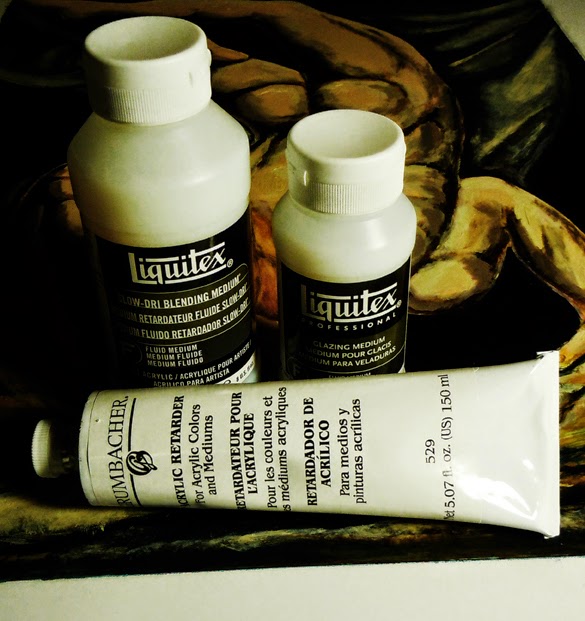Learn about the variety of mediums, gels and additives that expand the performance characteristics and physical properties of acrylic paint.
To change the characteristics of how an acrylic paint performs you can use a medium. Most often retarding mediums and slow drying mediums are used to slow the rate at which the paint dries, so you can blend colors on the substrate. Other mediums allow you to create glazes or to enhance how the paint wets the surface of the substrate. Some mediums give the paint more body which allow you to create textures. Still other mediums change the appearance of the paint imbuing the colors with an iridescent effect, while matte mediums can alter the naturally glossy appearance of acrylics.
The variety of mediums, gels and additives at your local art store can be mind boggling. If you paint with acrylics, some of the mediums that you should consider adding to your bag of tricks are listed below. The descriptions, hopefully, will help you make an informed purchasing decision.
Acrylic Retarder.
The good news is that acrylic paints dry fast. The bad news is that acrylic paints dry fast. The speed at which acrylics dry limits the time you have to blend colors. You could try watering down the paint, but that could weaken the binder as well as lessening the opacity of the color. The result is that the paint will not adhere to the substrate or another layer of paint sufficiently. Over time the paint can flake off of your painting. A better solution to slowing down the drying time is to add a retarder or a slow-dry blending medium.
A retarder is actually different than a medium. A medium consists of the same type of acrylic resin or binder that is in paint. A retarder is an additive that does not include any resin. When using a retarder, mix your colors first before adding this or any other type of medium. Because a retarder changes the chemical composition of the paint, limit the amount that you use to no more than 20% of the total volume of the paint/medium mixture. Using an excessive amount of retarder can compromise paint adhesion. You should also limit the amount of water used to no more than 20% .
Slow-Dri Blending Medium.
This glossy, transparent medium extends drying time for acrylic paints as well as improving adhesion and flexibility of the paint. Used as a thinner, this medium improves the flow out of the paint at the same time that it increases paint volume. The formulation is different than a retarder because it contains an acrylic binder, so you can add any amount without affecting paint adhesion. You can also use the Slow-Dri Blending Medium as a fixative over pencil, charcoal or pastel drawings. When using a blending medium, thoroughly mix 50% of the medium with 50% of the paint using a palette knife until the texture of the mixture is creamy.
Glazing Medium.
To increase the transparency of a color, blend in a glazing medium. Applying a glaze over a dried paint adds to the depth and complexity of a color. Glazing mediums are available in gloss, satin or matte finishes.
Gel Medium.
Thickening an acrylic paint with a gel medium allows you to create impasto textures.
Matte Medium.
Acrylic paints are naturally glossy. To reduce the gloss level, add in a matte medium. When gloss medium dries it is a clear film. Matte medium, on the other hand, tends to be a bit cloudy.
Flow Enhancer.
To create a color wash, many illustrators will thin an acrylic paint with water. The concern that many have is that this technique compromises the resin or binder. Flow Enhancers improve the flow of the paint by reducing the surface tension of the water without breaking down the binder or watering down the color.
Gels and Mediums.
When you shop for acrylic mediums, you will also find various gels stocked right next to them. What is the difference? Both products consist of the same type of acrylic polymer used in acrylic paint, but without the pigments. Think of them as clear paints.
A gel, however, has a thick consistency, similar to that of an acrylic paint as it is squeezed out of the tube. By using gels you can add texture to your painting. Brush strokes will be very visible.
If that is not the desired effect, a medium is the better choice, especially when you are applying glazes to your painting. Mediums are much thinner than gels, which allow the paint to level out for a smoother finish.
If you decide to purchase a gel, you will notice that they are available in different finishes: gloss, semi-gloss and matte. Be aware that the semi-gloss and matte varieties contain matting agents. When they dry, they are not perfectly clear as the gloss finish is. In fact, these finishes can have a noticeable cloudy appearance.



